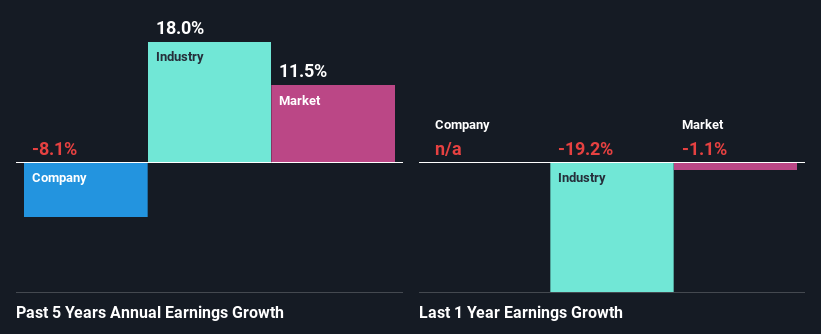Shanta Gold Limited's (LON:SHG) Stock is Soaring But Financials Seem Inconsistent: Will The Uptrend Continue?
Shanta Gold's (LON:SHG) stock is up by a considerable 13% over the past three months. However, we decided to pay attention to the company's fundamentals which don't appear to give a clear sign about the company's financial health. In this article, we decided to focus on Shanta Gold's ROE.
Return on equity or ROE is a key measure used to assess how efficiently a company's management is utilizing the company's capital. In short, ROE shows the profit each dollar generates with respect to its shareholder investments.
Check out our latest analysis for Shanta Gold
How Do You Calculate Return On Equity?
ROE can be calculated by using the formula:
Return on Equity = Net Profit (from continuing operations) ÷ Shareholders' Equity
So, based on the above formula, the ROE for Shanta Gold is:
8.2% = US$13m ÷ US$165m (Based on the trailing twelve months to June 2023).
The 'return' is the yearly profit. So, this means that for every £1 of its shareholder's investments, the company generates a profit of £0.08.
Why Is ROE Important For Earnings Growth?
Thus far, we have learned that ROE measures how efficiently a company is generating its profits. Based on how much of its profits the company chooses to reinvest or "retain", we are then able to evaluate a company's future ability to generate profits. Generally speaking, other things being equal, firms with a high return on equity and profit retention, have a higher growth rate than firms that don’t share these attributes.
Shanta Gold's Earnings Growth And 8.2% ROE
When you first look at it, Shanta Gold's ROE doesn't look that attractive. However, its ROE is similar to the industry average of 9.8%, so we won't completely dismiss the company. Having said that, Shanta Gold's five year net income decline rate was 8.1%. Bear in mind, the company does have a slightly low ROE. Hence, this goes some way in explaining the shrinking earnings.
That being said, we compared Shanta Gold's performance with the industry and were concerned when we found that while the company has shrunk its earnings, the industry has grown its earnings at a rate of 18% in the same 5-year period.
Earnings growth is an important metric to consider when valuing a stock. The investor should try to establish if the expected growth or decline in earnings, whichever the case may be, is priced in. This then helps them determine if the stock is placed for a bright or bleak future. Is Shanta Gold fairly valued compared to other companies? These 3 valuation measures might help you decide.
Is Shanta Gold Making Efficient Use Of Its Profits?
Shanta Gold's low three-year median payout ratio of 6.7% (implying that it retains the remaining 93% of its profits) comes as a surprise when you pair it with the shrinking earnings. This typically shouldn't be the case when a company is retaining most of its earnings. So there might be other factors at play here which could potentially be hampering growth. For instance, the business has faced some headwinds.
In addition, Shanta Gold has been paying dividends over a period of three years suggesting that keeping up dividend payments is preferred by the management even though earnings have been in decline. Looking at the current analyst consensus data, we can see that the company's future payout ratio is expected to rise to 9.9% over the next three years.
Conclusion
Overall, we have mixed feelings about Shanta Gold. Even though it appears to be retaining most of its profits, given the low ROE, investors may not be benefitting from all that reinvestment after all. The low earnings growth suggests our theory correct. With that said, we studied the latest analyst forecasts and found that while the company has shrunk its earnings in the past, analysts expect its earnings to grow in the future. To know more about the company's future earnings growth forecasts take a look at this free report on analyst forecasts for the company to find out more.
Have feedback on this article? Concerned about the content? Get in touch with us directly. Alternatively, email editorial-team (at) simplywallst.com.
This article by Simply Wall St is general in nature. We provide commentary based on historical data and analyst forecasts only using an unbiased methodology and our articles are not intended to be financial advice. It does not constitute a recommendation to buy or sell any stock, and does not take account of your objectives, or your financial situation. We aim to bring you long-term focused analysis driven by fundamental data. Note that our analysis may not factor in the latest price-sensitive company announcements or qualitative material. Simply Wall St has no position in any stocks mentioned.

 Yahoo Finance
Yahoo Finance 
